In today's dynamic commercial insurance landscape, effective debt recovery has become increasingly crucial. With insurance losses in the U.S. property and casualty industry reaching $474.5 billion in 2022, the need for specialized recovery processes has never been more pressing. As delinquent debts grow more complex, involving multiple parties and jurisdictions, insurers must leverage every tool at their disposal to maintain financial stability.
Enter commercial debt recovery - a powerful method that allows insurers to recover delinquencies from policyholders. This blog will explore why understanding and effectively utilizing recovery strategies is vital for commercial insurance companies looking to optimize their debt recovery efforts and maintain a healthy bottom line.
The Importance of Effective Debt Collection
Effective debt collection is a cornerstone of financial health for insurers, playing a crucial role in both the bottom line and customer relationships. On the financial front, efficient debt recovery directly improves loss ratios by recovering aged debt. Significant recoveries often translate into lower premiums for policyholders, enhancing the insurer's competitiveness in the market.
Beyond the numbers, debt recovery strengthens the bond between insurers and their customers. By demonstrating a commitment to fair cost distribution, insurers show that they're actively working to keep premiums in check. This commitment doesn't go unnoticed – customers appreciate seeing their insurer fight on their behalf, often leading to improved satisfaction and loyalty.
Moreover, commercial debt recovery plays a vital role in maintaining the integrity of the insurance system as a whole. By holding responsible parties accountable, it serves as a deterrent against negligence. This process ensures that the cost of losses is borne by those at fault, rather than being spread across all policyholders. In essence, effective debt collection not only recovers funds but also reinforces the principles of responsibility and fairness that underpin the entire insurance industry.
Challenges in Debt Collection
While debt collection offers substantial benefits, it comes with its own set of challenges:
Statute of Limitations Issues:
- Time constraints can limit recovery opportunities
- Varies by jurisdiction, adding complexity for multi-state operators
Asset Location and Recovery Difficulties:
- Identifying and locating right-party contacts can be challenging
- Even when found, parties may lack assets to cover the debt
Best Practices for Navigating Delinquent Receivables in Debt Collection
To optimize debt recovery efforts, insurers should consider the following strategies:
#1 Early Identification of Recovery Potential
- Implement systems to flag potential delinquent cases
- Train your accounting team to recognize trending delinquencies
#2 Thorough Analysis of Aging Report Data
- Review and apply an internal strategy to each 30-day window of your aging report
#3 Timely Notice to Responsible Parties
- Promptly inform policyholders of agreed timelines to prevent payment delays for premium payment or deductible obligations
- Ensure notices meet all legal requirements company cultural standards of communication
#4 Effective Negotiation Techniques
- Use data-driven approaches to inform recovery decisions
- Implement a training program for soft-skill development of negotiation tactics
#5 Leveraging Technology for Management and Tracking
- Implement specialized recovery software for efficient case handling
- Use analytics to prioritize cases and track performance metrics
Partnering with specialized debt recovery firms can provide access to expertise and resources that may not be available in-house. These partnerships can significantly enhance recovery rates and efficiency.
The Future of Collections in Commercial Insurance Debt Recovery
Emerging technologies are set to revolutionize collection practices:
AI and Machine Learning:
- Enhance case analysis and predict outcomes
- Automate routine tasks, freeing up resources for complex cases
Blockchain:
- Improve transparency and security in debt recovery processing
- Facilitate faster, more secure information sharing between parties
Advanced Data Analytics:
- Quickly identify new collection opportunities
- Optimize recovery strategies based on historical data
These advancements promise to make debt recovery processes more efficient and effective. For instance, a report by McKinsey & Company suggests that AI and machine learning could reduce the cost of premium and deductible debt by as much as 30%, a significant portion of which could be attributed to improved collection processes.
Mastering Debt Recovery for Insurance Success
Understanding and effectively utilizing recovery strategies is vital for commercial insurance companies looking to optimize their debt recovery efforts and maintain financial stability. By leveraging a collection agency, insurers can:
- Improve financial outcomes through increased recoveries
- Enhance customer relationships by demonstrating commitment to fair practices
- Contribute to a more robust and accountable insurance ecosystem
At NSB, we specialize in debt recovery for commercial insurance companies. Our technology-driven approach, coupled with deep industry knowledge, has consistently delivered superior results for our clients. We offer:
- Cutting-edge AI, data analytics, and strategy development for delinquent premiums
- A proven track record of maximizing recovery and retention through effective insured communication
- Seamless integration with your existing processes and systems
Ready to enhance your debt recovery efforts and boost your bottom line?

